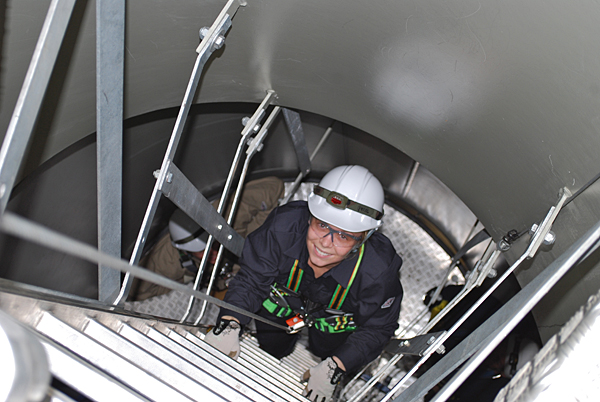Going with the wind
Students certified to facilitate research at top of wind turbine
12:14 p.m., May 4, 2011--Graduate students DeAnna Sewell and Blaise Sheridan have taken the idea of “hands-on learning” to a whole new level. Literally. The pair earned certification to climb the University of Delaware’s 2-megawatt wind turbine and recently completed their first ascent to the top of the 256-foot-tall machine.
After climbing the ladder that scales the tower’s interior, a process that took about an hour, they poked their heads out the top of the nacelle, which houses the turbine’s mechanical and electrical components. Stretching out below them was UD’s Hugh R. Sharp Campus, a wide swath of brown marsh, and miles of Delaware Bay obscured by the clouds of an early spring day.
Campus Stories
From graduates, faculty
Doctoral hooding
"I’m not really afraid of heights," Sheridan said. "But you certainly found that out when you were sitting on top of the nacelle."
The trip to the top is to be the first of many for the students who are to facilitate turbine research by placing instrumentation used to gather data. During their recent ascent they took measurements for steel samples to be mounted for corrosion research and diagnosed a malfunction with a microphone being used in a bird and bat study.
The graduate students, who both have undergraduate engineering degrees, said being able to climb the turbine will benefit their future careers. Sewell, of Hobe Sound, Fla., is a master’s student in the Physical Ocean Science and Engineering Program who is developing computer models of underwater forces on offshore turbine foundations. Sheridan, a native of Tucson, Ariz., is earning his master’s degree in the Marine Policy Program and studying the environmental and social costs and benefits of wind energy. Sheridan is a College of Earth, Ocean, and Environment Magers Fellow this semester.
"This will make them extremely well qualified to work in the wind power field, as people regulating the wind industry, or as engineers in the wind industry," said Willett Kempton, professor of marine policy, who advises both students. "Not only are they learning the theory and basic principles, but also the very practical experience."
Kempton reviews research on the turbine as research director of the UD Center for Carbon-free Power Integration.
UD Facilities technicians Rodney McGee and Don Smith also were certified to climb safely, and have additional training for assisting with maintenance operations.
While having trained UD climbers will benefit both students and the UD turbine research program, Kempton said the university plans to tap only a select number of students for the privilege due to cost and time involved with the training. The students and staff took three online training courses that covered first aid and safety regulations. Then they attended a two-day fall protection course where they learned additional safety measures and emergency procedures, and practiced using the turbine’s ladder, which is divided by several platforms so climbers can take breaks. Per regulations, at least two certified climbers must be on site for any access, but only one can use the ladder at a time.
By the day of their first climb, which the health and safety officer from the turbine’s manufacturer supervised, the students were equipped with the proper safety equipment (items such as a full body harness, hard hat, gloves, and fire rated clothing) and ready to go.
"I don’t think you would get this anywhere else as part of a master’s degree, and let alone have a turbine on your campus," Sheridan reflected. "This is quite incredible."
Article by Elizabeth Boyle
Photos by DeAnna Sewell and Blaise Sheridan













